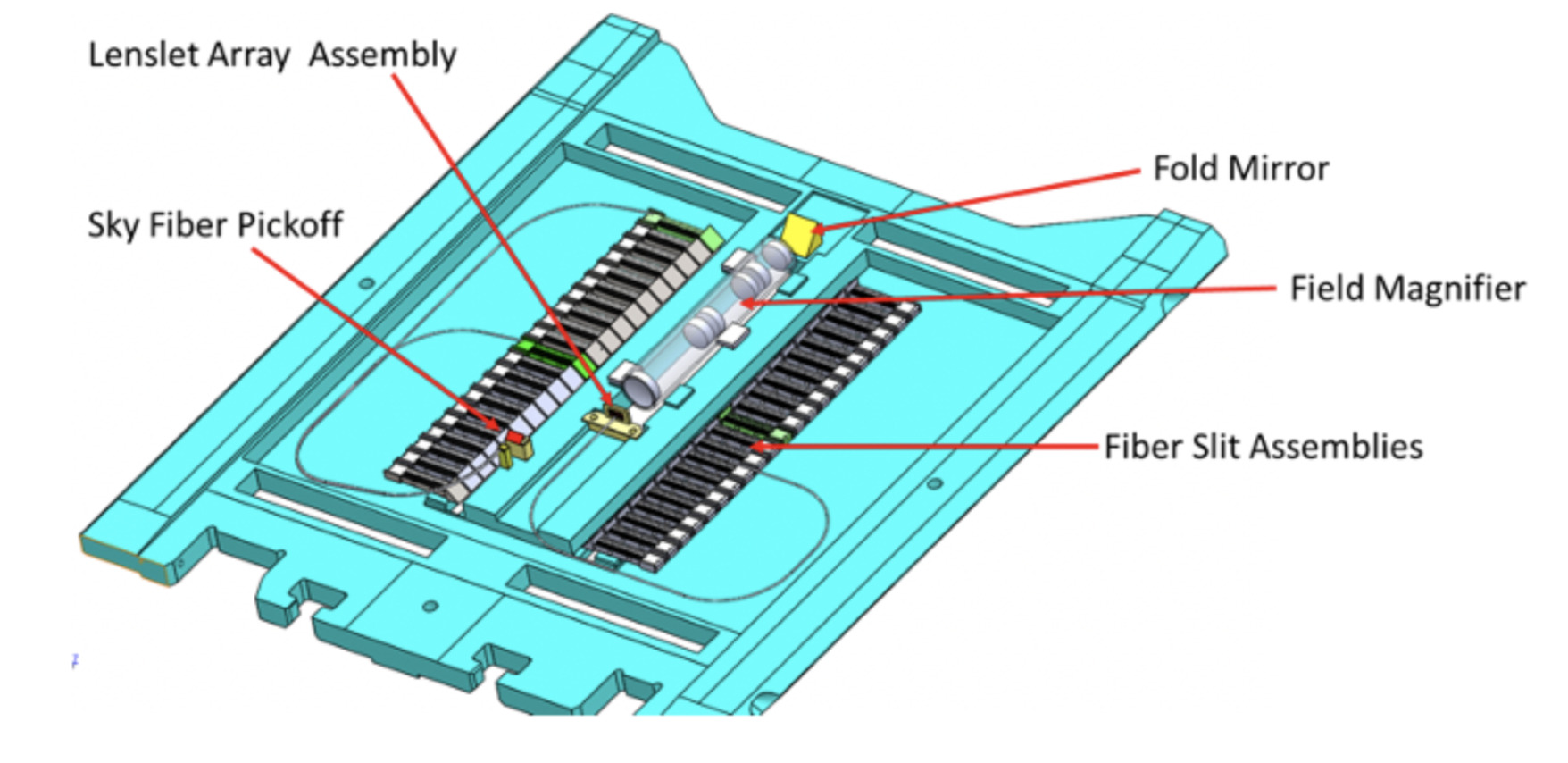Binospec IFU information
The Binospec Integral Field Unit
An Integral Field Unit (IFU) for Binospec has been built and is scheduled to be commissioned by the SAO instrument team in the Fall 2023 semester. First light through the IFU was obtained in December 2023. It will be available for shared-risk observing in the Spring 2024 semester, pending the results from the commissioning observations. This page describes the properties of the IFU as designed. Please note that all information is subject to change and updating as the IFU is commissioned.
Construction

The IFU is built into a unit, shown above, that is inserted into the instrument like a slitmask, near the focal plane of the telescope. The cyan section is a modified slitmask frame. A pickoff mirror (yellow) redirects light from the science field into magnifying optics (gray), then into a lenslet array, and optical fibers, which remap the field into pseudo-longslits on the two spectrographs of Binospec. A second, smaller pickoff mirror samples a sky area roughly 8 arcminutes from the field. The light from the fibers enters the Binospec collimators and is dispersed and imaged onto the detectors as if from a longslit.
Binospec IFU properties
The Binospec IFU will allow measuring spectra over a spatially 2-D area, a single rectangular science field of 16.5 x 12 arcseconds. There is one small separate, spatially offset sky field. The spatial elements (spaxels) are defined by hexagonally packed lenslets, 0.6 arcsec across on the sky, with almost 100% filling factor (without gaps, 0.6 arcsec side-to-side, 0.8 arcsec corner-corner). The IFU field of view is a rectangle longways east-west, so for a sky position angle of 0, the field spans 16.5″ E-W and 12″ N-S.
There are 720 fibers in total, 640 on the science and 80 on the sky fields. The spatial elements are remapped into pseudo-long-slits and dispersed by the usual Binospec optics, with spectral resolution and coverage roughly similar to using an 0.7″ wide longslit. The data images will contain roughly 720 individual spectra, half in each side of Binospec, lined up in pseudo-slits, as if each side of Binospec had a longslit with hundreds of elements in the slit.
For example, since the spectral resolution is set by the ~0.7″ spatial element, the resolution of the spectra will be about R ~ 1700, 5100, 5600 for the G270, G600, G1000 gratings respectively. (In practice it is measured at a little higher, and is also a function of wavelength, higher resolution at redder wavelengths.) The wavelength coverage is as shown in the table on the main Binospec page. The allowed central wavelength settings will be somewhat different, because this depends on the availability of a spectral line to the flexure control system at the requested grating angle.
The Binospec IFU spatial sampling of ~0.6-0.7 arcsec is well matched to typical seeing at the MMT and is large compared to other microlens IFUs, such as the GMOS IFU (0.2 arcsec). Thus, it is expected that the IFU will be more useful for low surface brightness observations than a high-spatial sampling fiber IFU, and may be able to do projects that are typically in the realm of image-slicer IFUs such as Keck/KCWI or VLT/MUSE. (With the caveat that the field of view and spectral coverage are not direct equivalents of either KCWI or MUSE and the sensitivity is not yet calibrated.)
IFU throughput, sensitivity, sky subtraction quality, and so on will be updated once commissioning data is available. The throughput per fiber appears to be roughly uniform to 5-10%, apart from about 4 broken fibers. The throughput losses in the fiber system are not precisely quantified yet but probably 30-50 percent; balanced against this, the IFU suffers less slit loss than a longslit in typical seeing.
Observing procedures
The Binospec IFU is inserted like a Binospec multi-slit mask. Handling procedures are still in development. It is likely that the IFU will be in the instrument regularly if it sees many requests for use. But since there are limited slots for masks, the IFU may not always be installed, and PIs must request it ahead of time. For example, a target of opportunity observation should not request the IFU unless this has been previously arranged with MMT staff.
Creating IFU targets
PIs can request the IFU in their MMT observing catalog forms, similar to how one chooses a longslit. Target acquisition is similar to the longslit, where the PI specifies the RA, Dec, and position angle (PA), and does not need to select guide stars manually. Binospec chooses the guide stars itself to set the target onto the IFU. However, PIs should be aware that the PA is not completely free:
- 1. Guide stars cannot always be found for a fixed PA, so allowing a range of position angles will give the observers more chances for a successful acquistion (eg specify PA=+25 but write in the target notes “a range of +/-10 deg in PA is acceptable”).
- 2. There are rotator limits near +/-180 in rotator angle. To avoid these, use a sky PA that is closer to 0 (ie within -90 to +90) for targets south of the MMT, Dec<+33; use a sky PA closer to +/-180 for targets north of the MMT.
The average overhead time required for an IFU observation has not yet been determined, but the current estimate used in the scheduler is the same as for a longslit or slit mask spectroscopic observation: an estimated 30 minutes for acquisition, calibration exposures, CCD readout, etc.
IFU data processing
Binospec IFU data will be reduced by a new mode of the existing Binospec pipeline. This mode is being tested with commissioning data obtained in December 2023, and details on the data products will be updated once we have more fully reduced data to work with. However, expect that the pipeline will evolve during the first semester or more of IFU operation.
